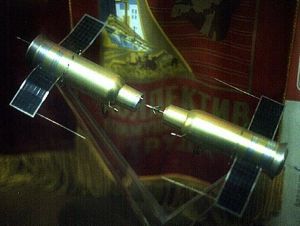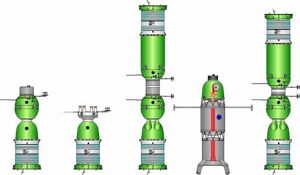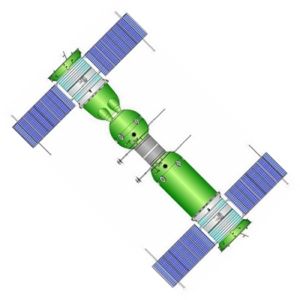
Home - Search - Browse - Alphabetic Index: 0- 1- 2- 3- 4- 5- 6- 7- 8- 9
A- B- C- D- E- F- G- H- I- J- K- L- M- N- O- P- Q- R- S- T- U- V- W- X- Y- Z
Soyuz R

Soyuz R
AKA: 11F71;7K-R. Status: Cancelled 1966. Gross mass: 13,000 kg (28,000 lb). Height: 15.00 m (49.00 ft).
The 11F71 was cancelled in 1966, with Chelomei's Almaz being developed instead.
In December 1962 Sergei Korolev released his draft project for a versatile manned spacecraft to follow Vostok. Among the designs was the Soyuz P interceptor and Soyuz R (Razvedki, intelligence) command-reconnaissance spacecraft. The VVS and the Strategic Rocket Forces supported these variants of the Soyuz. They were fully aware that the US Air Force's Manned Orbiting Laboratory was in the advance concept stage (it would be approved for development on December 10, 1963). But Korolev had no time to work on Soyuz 'side-lines'. Therefore he decided to 'subcontract' the military projects Soyuz-P and Soyuz-R to OKB-1 filial number 3, based in Samara (then Kuibishev), headed by Chief Designer Dmitri Ilyich Kozlov.
The Soyuz-R system consisted of two separately launched spacecraft, with the docked complex having a total mass of 13 metric tons. The small orbital station 11F71 would be equipped with photo-reconnaissance and ELINT equipment. This station was based on the Soyuz 7K, but the descent apparatus and living module were replaced with a storage section for modular equipment (this would later be developed further as a free-flyer spacecraft for the giant MOK orbital complex 19K, finally resulting in the 1990 (!) autonomous spacecraft 19KA30 Gamma). It was interesting to note that the external appearance of the Soyuz-R was very similar to pictures published on 1 November 1967 of the docking of Kosmos 186 and 188. These spacecraft were actually 11F615 7K-OK Soyuzes, but at that time the configuration was still secret. Therefore the configuration of the by-then cancelled 7K-R was used for the public release.
To dock with the Soyuz R 11F71 station Samara developed the transport spacecraft 11F72 Soyuz 7K-TK. This version of the Soyuz was equipped with rendezvous and docking equipment, including a hatch in the docking collar that allowed the cosmonauts to enter the station without donning space suits.
For Kozlov development of military spacecraft was nothing new. In 1961 he completed the technical documentation for the serial production of the photo reconnaissance satellite 11F61 Zenit-2, and from 1964, filial 3 undertook development of the 11F69 Zenit-4 reconnaissance satellite from draft project to production. Samara was also responsible for future development and production support of derivatives of the R-7 family of launch vehicles.
Soyuz-R was included by the Defense Ministry in the 1964-1969 five-year space reconnaissance plan. The decree on this subject was issued by Marshal Malinovksiy on 18 June 1964. By 1965 the Soviet Academy of Sciences, the military organs, and Ministry of General Machine Building had approved the advanced design project. Kamanin, the head of the cosmonaut corps, noted problems in training cosmonauts for the complex planned missions.
Vladimir Nikolayevich Chelomei headed a competing space design bureau OKB-52 and was Korolev's arch-rival. He had prospered in the early 1960's when he was backed by Khrushchev. On 12 October 1964, only two days before the overthrow of his patron, Chelomei obtained permission to begin development of a larger military space station, the Almaz. This 20 metric ton station would take three cosmonauts to orbit in a single launch of his UR-500K Proton rocket. Therefore in 1965 there were two competing projects in development for the same mission - Almaz and Soyuz-R.
In January 1966 Korolev died unexpectedly and OKB-1 was leaderless. Chelomei obtained a decision that the 11F71 Soyuz-R space station would be cancelled and the Almaz would be developed in its place. Almaz was assigned the 11F71 index number previously allocated to the Soyuz-R station, and Kozlov was ordered to hand over to Chelomei all of the work completed to that date. However at the same time the leadership directed that Kozlov's Soyuz-R 7K-TK ferry was to continue in development to transport crews to the Almaz.
Crew Size: 2. Habitable Volume: 18.00 m3.
Family: Manned spacecraft, Soviet Space Stations, Surveillance orbit. Country: Russia. Launch Vehicles: R-7. Agency: Kozlov bureau. Bibliography: 102, 121, 376, 474.
 | Kosmos 186/188 Kosmos 186/188 docking. Soyuz-R and OIS would have had a similar appearance. Credit: © Mark Wade |
 | Military Soyuz Comparison of military variants of Soyuz. From left to right: Soyuz P, Soyuz PPK, Soyuz R, Soyuz VI (Kozlov), Soyuz VI/OIS (Mishin) Credit: © Mark Wade |
 | Soyuz R Soyuz R military research laboratory (conceptual drawing based on description). Credit: © Mark Wade |
1962 December - .
- Soyuz draft project completed. - . Nation: Russia. Program: Soyuz. Spacecraft: Soyuz A, Soyuz B, Soyuz P, Soyuz R, Soyuz V. The draft project for a versatile manned spacecraft included the Soyuz-A circumlunar spacecraft, the military Soyuz-P fighter and Soyuz-R reconn bird..
1963 January 21 - .
- VVS Review of Soyuz - .
Nation: Russia.
Related Persons: Korolev.
Program: Soyuz.
Flight: Soyuz 11.
Spacecraft: Soyuz A,
Soyuz B,
Soyuz P,
Soyuz R,
Soyuz V.
The primary objective of the design is to achieve docking to two spacecraft in earth orbit. Secondary objectives are the operation of scientific and military equipment from the spacecraft. Three different spacecraft, all launched by an R-7 derived booster, are required to achieve this:
- 7K spacecraft, capable of carrying three men into space and returning them to earth. The 5.5 tonne spacecraft has three modules, including the BO living module and the SA re-entry capsule
- 9K booster stage, with a fuelled mass of 18 tonnes. After docking with the 7K this is capable of boosting the combined spacecraft to earth escape velocity. The 9K is equipped with a 450 kgf main engine and orientation engines of 1 to 10 kgf. It will have 14 tonnes propellant when full loaded. Four sequential docking with a tanker spacecraft will be required to fill the tanks before the final docking with the 7K.
- 11K tanker, with a mass of 5 tonnes.
The system will conduct fuellings and dockings in a 250 km altitude parking orbit, and be boosted up to 400,000 km altitude on lunar flyby missions. The system will be ready in three years. Military variants proposed are the Soyuz-P and Soyuz-R. Each spacecraft will have 400 kg of automatic rendezvous and docking equipment. Manual docking will be possible once the spacecraft are within 300 m of each other.
Korolev still insists on an unguided landing and categorically rejects the use of wings. A parachute will deploy and slow the capsule to 10 m/s. Then a retrorocket will fire just before impact with the earth to provide a zero-velocity soft landing. Korolev still insists that spacesuits will not be carried for the crew. First test flight of the 7K, without docking, could not occur until the second half of 1964.
1963 March 20 - .
- Soyuz draft project was submitted to the expert commission - .
Nation: Russia.
Spacecraft: Soyuz A,
Soyuz B,
Soyuz P,
Soyuz R,
Soyuz V.
Aside from the baseline Soyuz-B circumlunar mission, the draft project also proposed the Soyuz-P space interceptor and the Soyuz-R command-reconnaissance spacecraft. The military projects Soyuz-P and Soyuz-R were 'subcontracted' to OKB-1 Filial Number 3, based in Samara. The Soyuz B circumlunar version did not receive the same level of financial support.
1964 Duing the year - . Launch Vehicle: R-7.
- Development of Soyuz-R and Soyuz-P begun. - .
Nation: Russia.
Related Persons: Kozlov.
Program: Almaz.
Class: Manned.
Type: Manned spacecraft. Spacecraft: Soyuz 7K-TK,
Soyuz P,
Soyuz PPK,
Soyuz R.
KB Kozlov began active development of the military applied versions of the Soyuz. A new version of the R-7 launch vehicle, the 11A514, was put into development to support launch of the Soyuz-P, now designated the 7K-PPK (pilotiruemovo korablya-perekhvatchika, manned interceptor spacecraft). The Soyuz-R would include the small orbital station 11F71 with photo-reconnaissance and ELINT equipment. To dock with the 11F71 station Kuibishev developed the transport spacecraft 11F72 7K-TK. This version of the Soyuz was equipped with rendezvous, docking, and transition equipment, including an airlock, that allowed the two cosmonauts to enter the station without using EVA. The launch vehicle for the 7K-TK would be the 11A511, known today as the Soyuz.
1964 January 3 - .
- Military Soviet of the VVS Staff - .
Nation: Russia.
Program: Lunar L1.
Flight: Soyuz A-1,
Soyuz A-2,
Soyuz A-3,
Soyuz A-4.
Spacecraft: Soyuz A,
Soyuz P,
Soyuz PPK,
Soyuz R.
No significant decisions are made. Discussion of the 3 December 1963 resolution to start development of the 7K Soyuz spacecraft. Although the resolution foresees completion of the first spacecraft during 1964, and first flights in 1965-1966, there is not one word on training of cosmonauts for such missions. Scientific versions, for manned flight to the moon and planets, as well as military variants, are foreseen.
1964 February 15 - .
- American space plans - .
Nation: Russia.
Related Persons: Bykovsky,
Gagarin.
Spacecraft: Almaz APOS,
MOL,
Soyuz PPK,
Soyuz R.
Following an overview of the planned trip of Bykovsky and Gagarin to Sweden and Norway on 1-15 March, American military space plans are reviewed. There are many fantastic projects, over a wide and well-financed front. Currently reconnaissance satellites are flying, to be followed by inspection, and then anti-satellite satellites in 3 to 5 years. After that manned military space stations are planned, manoeuvrable manned spacecraft, and the establishment of scientific and military bases on the moon. Despite this big US program, the Soviet military leadership shows no interest in Russian exploitation of space for military purposes.
1964 February 27 - .
- Military space plans - .
Nation: Russia.
Related Persons: Malinovskiy.
Spacecraft: Soyuz PPK,
Soyuz R.
A meeting of the VVS General Staff with Marshal Malinovskiy reviews military roles in space. The VVS are tasked with developing environmental control systems for manned spacecraft, abort and recovery systems, training cosmonauts, and recovery of returned space capsules. The RVSN are responsible for final check-out and launch of spacecraft; the PVO are responsible for tracking and control of manned spaceflights. Kamanin pushes for VVS to take a role in development of manned military spacecraft as an extension of its responsibility for combat aircraft. Some of the generals agree in principle, but have no understanding of the new technology and how it might be appropriately applied. Others are opposed. Meanwhile the cosmonauts are taking their examinations in avionics technology, and Kamanin continues to argue for reorganisation of the TsPK cosmonaut training centre to include new specialities and training facilities (e.g. to support specialist engineer, navigator, and scientist cosmonauts).
1964 June 18 - .
- USSR five-year military space plan issued. - .
Nation: Russia.
Related Persons: Chelomei,
Malinovskiy.
Spacecraft: MiG 105-11,
Raketoplan,
Soyuz R,
Spiral OS,
US-A,
US-P,
Zenit-2M satellite,
Zenit-4M.
Ministry of Defence Decree 'On military space programs for 1964-69, including the R spaceplane' was issued. The decree was issued by Defence Ministry Marshal Rodiono Yakovlevich Malinovksiy. Included in this plan were new versions of the automatic Zenit, Morya-1 (US series) spacecraft, the Spiral spaceplane, the Soyuz-R manned combat spacecraft, and others. Chelomei's Raketoplan spaceplane was cancelled.
1964 October 12 - . LV Family: Proton. Launch Vehicle: Proton-K.
- Almaz project starts - .
Nation: Russia.
Related Persons: Chelomei.
Spacecraft: Almaz APOS,
Soyuz R.
The day before the overthrow of his patron, Chelomei obtained permission to begin development of a larger military space station, the Almaz. This 20 tonne station would take three cosmonauts to orbit in a single launch of his UR-500K Proton rocket. Therefore there were now two competing projects for the same mission - Almaz and Soyuz-R. First flight of the Almaz, with a one year operational period, was set for 1968.
1965 February 2 - .
- Cosmonaut organisation - .
Nation: Russia.
Related Persons: Beregovoi,
Malinovskiy,
Nikolayev.
Program: Lunar L1,
Lunar L3.
Spacecraft: LK-1,
Soyuz A,
Soyuz B,
Soyuz PPK,
Soyuz R,
Soyuz V.
Kamanin will organise the cosmonauts into two groups: the first group will be commanded by Nikolayev, and the latest group by Beregovoi. They will be assigned to support and train seven missions: military space (reconnaissance, interceptor, and combat spacecraft); space navigation; life support and rescue systems; communications and telemetry systems; scientific orbital stations; lunar fly-by; and lunar landing expeditions. All of this may be for nought, since Marshall Malinovskiy has said that heavy launch vehicles and lunar flights have no military utility and should be funded and handled by the Academy of Science.
1966 March 30 - .
- Soyuz R Cancelled; Soyuz 7K-TK to be ferry to Almaz station - .
Nation: Russia.
Related Persons: Chelomei,
Kozlov.
Spacecraft: Almaz OPS,
Soyuz 7K-TK,
Soyuz R.
Ministry of General Machine Building (MOM) Decree 145ss 'On approval of the 7K-TK as transport for the Almaz station' was issued. It was decided that the 11F71 Soyuz-R space station would be cancelled and the Almaz would be developed in its place. Almaz was assigned the index number previously allocated to the Soyuz-R station, and Kozlov was ordered to hand over to Chelomei all of the work completed in relation to the station. However Kozlov's Soyuz 7K-TK ferry was to continue in development to transport crew to the Almaz.
Back to top of page
Home - Search - Browse - Alphabetic Index: 0- 1- 2- 3- 4- 5- 6- 7- 8- 9
A- B- C- D- E- F- G- H- I- J- K- L- M- N- O- P- Q- R- S- T- U- V- W- X- Y- Z
© 1997-2019 Mark Wade - Contact
© / Conditions for Use